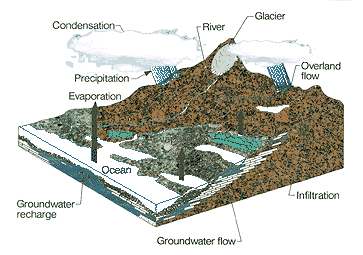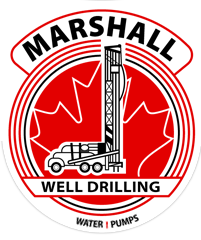Drilling Facts
ALMOST ALL YOU NEED TO KNOW
ABOUT WELL DRILLING
Our intention with this page is to answer some questions that people may want to know about having a well drilled.
The thrill of the drill, is in the adventure and anticipation of “How deep?” and “How much water?”. In a way it has the same thrill as drilling for oil, except you find something better, precious water.
The experience of having a well drilled is one that amazes almost every homeowner. The varied reasons are:
-
The size of the drill rig
-
The support vehicles
-
The functioning well
-
The well location
Most people are used to merely turning a faucet to get a drink of water. The process by which water is found is not quite so easy. There is far more water travelling and flowing through bedrock and overburden than freely flows by in the thousands of rivers that etch the surface of our planet. Water bearing bedrock, sand, and gravel are technically named aquifers. The well drillers’ job is to drill a hole into the earth’s surface and extract an adequate supply of water from the aquifer. The depth of a well in the Near North Region can be between 50 and 500 feet (15 to 150 meters). The average depth is usually between 160 and 250 feet (50 to 75 meters).

Homeowners that arrive on the site, after the well has been drilled in their yard, see little evidence of the hard work and energy that has gone into drilling the well. The only thing left to see is a two foot height of pipe and a well cap surrounded by a little gravel and some rock cuttings. The pump installers are next on the scene to hook up your new submersible pump system. Now it’s time to turn on the tap!
When a well driller arrives to inspect the site to locate the well, there are only a few essential issues:
- Location of a septic system
- Plumbing accessibility and proximity
- Equipment or machinery access
- Topological obstacles such as trees, buildings, driveways, utilities and roads
- Seasonal access issues like mud and snow.
- Soil type:
- Sand
- Gravel
- Clay
- Granite (rock type)
Well Placement
Water is found almost everywhere in this part of the world. Aquifers run through or nearby, every inch of ground in Central and Northern Ontario. In Ontario, the biggest concern is in the location distances from septic systems; a well must be situated a minimum of 50 feet from all parts of the septic system. Each environmental jurisdiction has different criteria for placing a well from sewage. Wells must also not be located in runoff streams nor any other water flow area such as ponds and ditches, or other sources of potential contamination.
Soil Conditions
A key issue that the well driller faces are the local soil conditions.
-
Sand and gravel wells require casing the entire depth of the well and sometimes a screen at the base of the well to permit water into the well pipe. The casing and screen prevent the well from filling in with sand and gravel.
-
Rock is resilient to this problem, but may need to be Hydro-fractured so the aquifer is connected to the well.
-
Casing must be installed (min. 20 feet) even if bedrock is at the surface.
-
Broken rock layers may require additional smaller casing known as a packer.
Methods for fracturing the base of a well if needed are: Hydrofracking- Using water under extreme pressure to split the rock until the aquifer is reached. This is the most reliable method and doesn’t damage the well.











